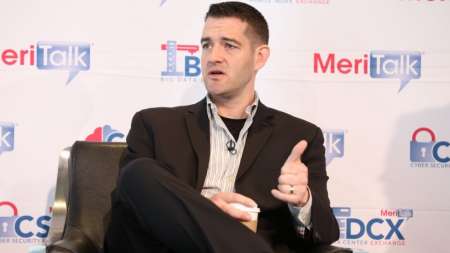Bot-driven cyberattacks and other fast-spreading malware have been making some pretty big waves of late. The Mirai botnet, for example, launched several record-setting Distributed Denial-of-Service–DDoS–attacks starting in September 2016. […]
At the RSA Cybersecurity Conference in San Francisco, Department of Homeland Security (DHS) Secretary Kirstjen Nielsen made it clear that the United States has “a full spectrum of response options” to defend against cyber attacks and hacks. […]
The Department of Defense (DoD) Empire just struck back with answers to more than 1,000 questions that vendors posed regarding the Joint Enterprise Defense Infrastructure (JEDI) cloud contract. DoD just released its second draft request for proposal after responding to concerns of 46 vendors and two associations. […]
Uncle Sam’s Russopobia got a shot in the arm from a recent Department of Interior (DOI) Inspector General report. […]
Last month, the Department of Homeland Security issued a rare public alert about a large-scale Russian cyber campaign targeting U.S. infrastructure. The news raised serious concerns about vulnerabilities in the nation’s power grid and other critical infrastructure assets. […]
It’s not often that anyone aspires to “go slow” to reach their goals, but for Shane Barney, Acting Chief Information Security Officer for the U.S. Citizenship & Immigration Services, it’s part of the plan. […]
As every serious runner knows, preparing for a big race can be a daunting task; it takes time, patience, and determination to succeed. Once the training schedule begins, the runner must be diligent with sticking to the task. By neglecting even one workout, the runner can risk losing progress, and not finish the race. […]
Yogi Berra told us it’s like déjà vu all over again–and cyber stalkers let out a huge yawn at yesterday’s House Armed Services Committee hearing on cyber operations. This torturous exercise in reviewing technology security and public safety challenges associated with critical infrastructure was studded with the clichés and platitudes that set our nation up for a massive kinetic cyber attack. […]
Security is the great white whale of Federal IT–even as we make progress, it is just out of reach. Late last month, Zscaler announced it had prioritized rigorous security standards by achieving the Service Organization Control (SOC) 2, Type II Certification. […]
Facebook CEO Mark Zuckerberg’s marathon Congressional sessions in front of both the House and Senate have produced countless talking points and incendiary sound bites. […]
The world over, folks ask the same two questions every day–what’s for dinner, and what’s the weather forecast? In the government IT space, every day we’re all asking about the cloud forecast. A recent report from P&S Market Research provides new insights on the global government’s cloud appetites. […]
The Government Accountability Office–GAO–recently released a report on an artificial intelligence forum it held in Washington, D.C. last summer. It shows that government’s thinking about the ups and downs of thinking machines. Two highlights to make you think. […]
On any given day, you might find Mike Maiorana traveling across the country to meet with his most valued stakeholders–his customers and his team. But it wasn’t always digital jet setting for the Jersey boy who graduated from Rutgers in 1990 with a marketing degree. […]
Cybersecurity is at the heart of IT modernization. While modern technologies provide agility and convenience, a core requirement of new solutions is the ability to respond to new threats. […]
The journey to meet the requirements of the Data Center Optimization Initiative (DCOI) has been long, difficult, and full of roadblocks–and, from the back seat, we can hear anxious voices asking when the trip will be over. With the extension earlier this year of the 2018 DCOI deadline to 2020, agencies are clearly still looking for the right routes to take. […]
Scientists at the Army Research Laboratory (ARL) are covering some new ground in artificial intelligence (AI) by connecting a machine with human intelligence via a neural connection. Not to worry: the research team isn’t cooking up an AI system that will run the show inside a person’s head. But it does have promise for both medical as well as deep machine learning systems uses, potentially in military and everyday applications. […]
Action plans to accelerate Federal agency migrations to cloud platforms and services as outlined in the White House IT Modernization Report have been in effect for nearly three months now. For instance, the Office of Management and Budget (OMB) was directed to conduct a data call within 30 days of the report’s release, requesting agencies to identify systems that might be ready for cloud migration, but have not because of some perceived or encountered difficulties. […]
Jay Huie, Cloud Portfolio Director for GSA’s Technology Transformation Service (TTS)–which includes FedRAMP–sat down with MeriTalk last week. He offered insights on his role at GSA, FedRAMP, and the perspective on the road ahead for cloud adoption, FITARA, and MGT. […]
The Army recently added 18 more vendors to its $250 million Army Cloud Computing Enterprise Transformation (ACCENT) contract, which kicked off last year with 50 vendors certified as meeting the Army’s requirements for cloud services. […]
The new President’s Management Agenda solidified the administration’s focus on IT modernization. In the 54-page agenda, released last week, the White House laid out its roadmap for improving the Federal government. Central to its plans? Modernizing the government’s IT infrastructure. […]
Last week, the National Institute of Standards and Technology (NIST) revealed the initial public draft of its Special Publication 800-160 Volume 2, Systems Security Engineering: Cyber Resiliency Considerations for the Engineering of Trustworthy Secure Systems. […]
Most Federal managers grasp the concept of automation, the use of technology to perform a process or procedure without human assistance. However, do they really understand the role of automation, and how it can be applied to accelerate delivery and management of IT resources and applications, especially in this era of multi-clouds? […]
The U.S. military has long laid claim to having the best-equipped, best-trained fighting force in the world, and to spending more on defense than the next eight top-spending nations combined. But when the battleground is cyberspace, does that claim hold up? […]
It’s an old axiom: “you can’t manage what you can’t measure.” And nowhere is that axiom truer these days than with Federal IT investments. Federal executives need to better understand, manage, and show value from money spent on IT resources. […]
It is imperative for Federal agencies to effectively utilize threat intelligence combined with the power and agility of the cloud to better defend their networks. But, today, agencies are lacking adequate situational awareness to give their IT and security teams more clarity about what is going on in their networked environments. So, what’s holding them back? […]
The Department of Homeland Security’s (DHS) rare public alert last week about a large-scale Russian cyber campaign targeting U.S. infrastructure raised a piercing alarm about vulnerabilities in the nation’s power grid, and underscored what officials have meant when talking about the need for a whole-of-government and whole-of-nation approach to cyber defense. Protecting against a major attack, managing the damage once one hits, and responding to an attack are beyond the reach of any one agency or sector, they argue; the job requires concerted efforts from the public and private sectors. […]
While Federal agencies race to migrate to the cloud, security concerns seem to multiply by the hour. This month alone, Russian hackers penetrated the U.S. power grid; cyber attackers got into the network of a petrochemical company in Saudi Arabia in hopes of triggering an explosion; and North Korean hackers apparently “blitzed” Turkish banks and government organizations to gather intel for a future heist. […]
Opening day for the Nationals might be a week away, but four Beltway insiders have already knocked one out of the park. The latest omnibus spending bill, which passed through the Senate early Friday morning, includes $100 million for the MGT Act’s centralized revolving capital fund. President Trump signed the MGT Act into law late last year as an amendment to the National Defense Authorization Act. […]
The tactics of warfare aren’t what they used to be. In addition to asymmetric battlefield tactics that differ from conventional battles, they also can include cyber, social, economic, and psychological strategies that don’t necessarily involve physical combat or destruction–or even direct human involvement–and can’t be divined by tracking troop movements or fleet deployments. As a result, the signs of impending war aren’t what they used to be either. […]
Agencies are rolling out aspects of the Continuous Diagnostics and Mitigation (CDM) Program with varying degrees of speed and success, but the inherent benefits of the program are not being questioned. […]























